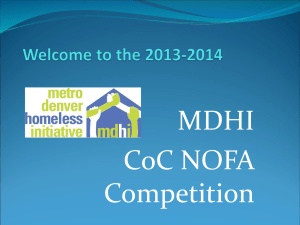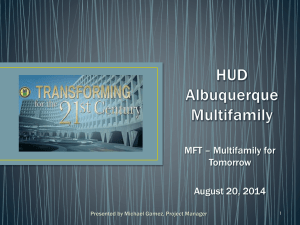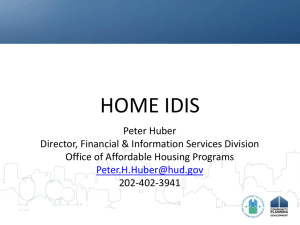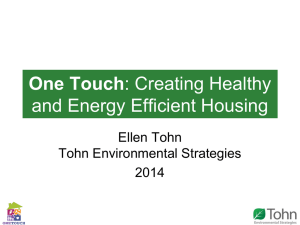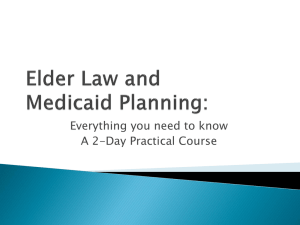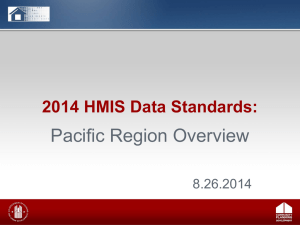2012 HUD Continuum o..
advertisement
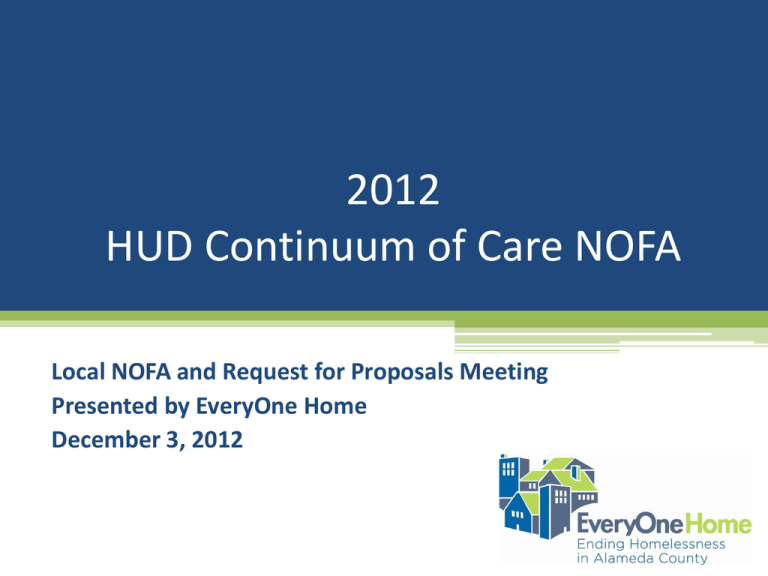
2012 HUD Continuum of Care NOFA Local NOFA and Request for Proposals Meeting Presented by EveryOne Home December 3, 2012 2 Agenda 1. 2. 3. 4. Review of HUD NOFA Local Process and Priorities Local Renewal Projects Application Requirements Local New Projects Application Requirements Break 5. Q & A re: e-snaps Project Applications (formerly Exhibit 2) 3 Key Dates • 7/14/2012:Continuum of Care Interim Rule released • 9/26/2012: Community meeting on NOFA options • 11/9/2012: C of C NOFA released • 12/3/2012: Local application released • 12/19/2012: Local apps due and renewal e-snaps to be complete • 1/3/2013: Local applicants notified of status • 1/18/2013: C of C application due to HUD • 3/1/2013: Approximate date for 1st round of award notifications 4 The HUD NOFA: It’s different alright Used to be Three programs SHP Shelter Plus Care Section 8 Mod-Rehab Now A single program: Continuum of Care with Four Components 1. Permanent Housing (Rapid Rehousing or Permanent Supportive Housing) 2. 3. 4. Transitional Housing Supportive Services Only HMIS 5 2012 HUD CoC NOFA Is Still Focused on PSH Permanent Housing Bonus Project must be PSH for chronically homeless individuals and families Consistent with Open Doors call to end chronic homelessness by 2015 And surprising in light of HUD’s recent encouragement of rapid rehousing New This Year Defines and prioritizes Extreme High Needs communities for bonus Allows Reallocation from 1 or more SSO projects to Implementation of Coordinated Assessment Allows CoC’s to request up to 1.25% of package for a CoC Planning Grant 6 2012 HUD CoC NOFA Scoring and Process Still Emphasizes performance of both CoC and projects Demonstrates a commitment to renewals and the “hold harmless amount” New This Year “HUD strongly encourages CoC’s to prioritize those projects that are effective and high-performing” pg. 32 Adds expending grant $ as a performance measure. pg. 6 Likely to add more performance measures in future Allows reallocation of unspent funds and low performing projects to “new” permanent housing. “HUD strongly encourages CoC’s to take advantage of this option” pg. 6 7 2012 HUD CoC NOFA Application Still Has CoC Application (Exhibit 1) that earns the points New This Year Detailed breakdown of 130 pts Project Applications (Exhibit 2) that must be rated and ranked Priority Listings as a separate section (No Guidance yet) Rating and Ranking broken into 2 tiers CoC Performance = 34 pts CoC Strategic Planning = 55 Housing, Services & Structure = 14 Leveraging = 6 HMIS = 13 2012 Point in Time Count = 8 Tiering in the 2012 CoC NOFA 8 Alameda County’s Annual Renewal Demand (ARD) = $24,812,077* ARD is the total amount of all the CoC’s projects that will be eligible for renewal this year. The national appropriation for the entire CoC program ($1.61 billion) is 3.5% less than the national ARD. This means HUD does not currently have enough funding for all renewals. Thus, HUD has established the following tiering process. CoC ARD $24.8 million* TIER 1 $23.9 million* Alameda County TIER 1 = $23,943,654* Tier 1 is the CoC ARD less 3.5%. HUD will first allocate funding to projects in Tier 1 for all CoC’s. All projects in Tier 1 are expected to be funded. TIER 2 = difference in renewal demand Tier 2 represents the difference in renewal demand. In Alameda County, $868,423 of renewal demand will fall into Tier 2. TIER 2 *This amount is lower than what was published by HUD in the NOFA because one recently funded local project will not be renewing this year. HUD will not begin funding projects in Tier 2 (for any CoC) until ALL grants in Tier 1 (for all CoC’s) have been funded. Projects in Tier 2 are potentially vulnerable to not receiving funding. Alameda County TIER 1 = $23,943,654* 9 HUD will fund ALL projects in Tier 1 before funding ANY projects in Tier 2. HUD will fund Tier 1 projects in the following priority order. Because ALL Tier 1 projects are expected to be funded, this order is essentially inconsequential in Tier 1. HUD’s Selection Priority for Tier 1 Projects: CoC ARD $24.8 million* TIER 1 $23.9 million* 1) 2) 3) 4) 5) Renewal projects New projects created through reallocation CoC Planning costs Permanent Housing Bonus projects located in designated “Extreme High Needs” communities. (We don’t know whether our CoC will receive this designation; we have not heard any indication of this from HUD.) New Permanent Housing Bonus projects #6 through #10 do not apply to our CoC TIER 2 *This amount is lower than what was published by HUD in the NOFA because one recently funded local project will not be renewing this year. TIER 1 #55 Renewal Project $ #56 Renewal Project $ #57 Renewal Project TIER 2 #58 Renewal Project $ $ TIER 2 10 Once ALL Tier 1 projects for ALL CoC’s have been funded, HUD will begin allocating funding to projects in Tier 2 as much as funding allows. HUD will begin by funding projects of its first Selection Priority, beginning with the highest-scoring CoC and continuing through the lower-scoring CoC. HUD will then move down to its second Selection Priority, highest-scoring CoC through lowest-scoring CoC and so on, until funding runs out. HUD’s Selection Priority for Tier 2 Projects: #59 New Project Created Through Reallocation $ #60 Renewal Project $ #61 PH Bonus Project $ #62 CoC Planning Costs $ Please note: This is for explanatory purposes only and is not intended to reflect actual ranking in our CoC. 1) 2) 3) 4) Renewal projects New projects created through reallocation CoC Planning costs Permanent Housing Bonus projects located in designation “Extreme High Needs” communities. (We don’t know whether our CoC will receive this designation; we have not heard any indication of this from HUD.) #5 through #9 do not apply to our CoC 11 Where could funding for Tier 2 projects come from? Currently, HUD only has enough funding for all projects ranked in Tier 1 nationwide. Funding for projects ranked in Tier 2 will become available depending on how much funding HUD is able to recapture from previously unspent funds and/or unallocated Tier 1 funding. The higher our CoC score is, the higher the likelihood of our Tier 2 projects receiving funding will be. When will projects be notified of whether they will receive funding? Tier 1 Projects: HUD will notify Tier 1 projects 45 days after the NOFA deadline. All Tier 1 projects are expected to be funded. NOFA deadline: January 18th, 2013 Tier 1 projects notified: Approximately March 1st, 2013 Tier 2 Projects: HUD will notify Tier 2 projects after Tier 1 projects, but no specific timing has been announced. Depending on how quickly HUD is able to assess the amount of funding available for Tier 2, these projects could be notified anytime during 2013 after March 1st. There is no guarantee that Tier 2 projects will be funded. 12 Local Process and Priorities 13 Our Local Process • In August the EveryOne Home Leadership Board appointed a NOFA Committee charged with: ▫ soliciting community input ▫ evaluating the HUD NOFA ▫ Determining the local application strategy for maximizing the dollars and effectiveness of the package ▫ approving the local RFP, rating and ranking the proposals, and ▫ approving the final selection and ordering of projects to be included in the package. 14 The NOFA Committee • A sub-committee who were non-applicants or potential applicants worked with staff to develop the application and scoring, and will be rating and ranking the local submissions 15 The Committee’s Approach • Participated in the September Community Mtg and helped develop guiding principles and review NOFA options. • Met 6 times since to develop the application and approach being outlined today. 16 The Committee’s Approach • Recognized that this is a transition year for our community as well as HUD. ▫ We are an interim decision making body for 1 yr ▫ We are laying the groundwork for future years of using performance standards in funding decisions ▫ We will continue refine our approach to the NOFA throughout the year 17 What We Heard The feedback we heard from the community at the meeting, through survey and a conference call. Desire to prioritize renewals and: Focus on performance improvement Allow for and encourage voluntary conversions of TH and SSO to PH Interest in creating a pool of funds from unspent or poor performing projects that opened the door for new permanent housing projects 18 The NOFA Strategy • Prioritizes Renewals, which means: ▫ All renewals that submit a response to the local RFP on time will be included in the application package to HUD, including new projects created with reallocated funds or converting projects. ▫ As a renewing project and essential for C of C funding, HMIS will be in tier 1. ▫ Projects that increase the overall package amount—the permanent housing bonus project and the C of C planning dollars will be included in the package only in ways that do not jeopardize renewals. 19 The NOFA Strategy • Emphasizes performance as the basis for rating projects this year and in future years: ▫ HUD has determined that expending grant funds is a performance measure. We are scoring expenditures starting this year and going forward. ▫ Data accuracy and completeness is also a HUD performance measure. HUD will score the CoC. We will score each project now and going forward. ▫ The $123,000 in reallocated funds available for a new project were given up voluntarily by the grantees. 20 The NOFA Strategy • Emphasizes performance cont…: ▫ Higher performing projects will be ranked in Tier 1, The lowest performing renewals are most likely to be ranked in tier 2. ▫ No projects will be involuntarily reallocated or excluded from the package this year due to low performance. ▫ Starting next year lower performing projects and unspent funds may be considered for reallocation. 21 NOFA Strategy and Local Apps The Committee did its best to create a process that: • Responds to requirements dictated by HUD and • Builds on our strengths • Continues to reorient our system to ensure that we rehouse those who lose their housing as rapidly and cost effectively as possible • deploys proven strategies and target resources to best practices, maximizes dollars at the front line, and uses data and performance to make choices From the Guiding Principles 22 Renewal Applications 23 Renewal Project Applications • Complete Project Application in e-snaps • Complete Local application and email to EveryOne Home@acgov.org • Include back-up documentation in a PDF • Both parts due December 19, by 4:59:59 pm 24 Overview • Application includes questions needed by EveryOne Home to complete CoC Application (e.g. Mainstream resources, education) • Application focuses on performance on various indicators – aligns with the information required in CoC Application and HUD concerns and priorities • Lower performers required to submit Performance Improvement Plan 25 1. General Section • Information about Project and applicant • Information needed for CoC Application • Points on this section for: – Project Type – up to 10 points – Completeness of overall application and responses – up to 5 points – Attending this meeting (Congratulations! You just got 5 points) 26 2. Outcome Measures • Using information from HMIS and from APR’s, complete outcomes measure charts for the project types • Points on this section up to 45 27 2. Outcome Measures • Measures required and benchmarks different for different program types – Obtains or Retains Permanent Housing – Earned Income or Any Income at exit for enterig without income – Exit to Known Destination – All – Points based on proximity to local benchmarks • PIP required on measures for which applicant receiving no points 28 Info from HMIS outcome reports 29 Info from APR (PSH and SSOs tied to housing only) Length of Participation by Exit Status Number of Persons Total Less than 30 days Leavers A Stayers H 31 to 60 days B I 61 to 180 days 181 to 365 days 366 to 730 days (1-2 Yrs) C J G P 731 to 1095 days (2-3 Yrs) 1096 to 1460 days (3-4 Yrs) 1461 to 1825 days (4-5 Yrs) More than 1825 Days (>5 Yrs) Information Missing Total Housing Retention >6 months: (P – H – I – J + G) – A – B – C / (P – H – I – J + G) 30 3. Spending • Report on amount of unspent funds for past two program years; explain any issues • Points on this section up to 10 • Points based on amount and pattern of spending • PIP required if high rate of unspent funds for last two years 31 4. HMIS • Report on data quality for required Universal data elements using Bowman “Data Quality Report Card” • Points on this section up to 10 • Points based on percent of data quality • PIP required if lower than 80% on scorecard 32 Data quality report card 33 5. Leveraging • • • • Complete Leveraging Chart in e-snaps Summarize amounts in local application Points on this section up to 10 Points based on ratio of leveraging to HUD request 34 6. Performance Improvement Plan • For all performance measures (sections 2, 3 and 4 above) complete PIP for any with 0 score • PIP describes strategies that will be used to improve and measurable progress to be made by June 30 and September 30, 2012 • Points on this section up to 20 – only available if received a score of “0” in corresponding section 35 Performance Improvement Plan Outcome Measure Performance Improvement Plan Template (pg 13 of Renewal RFP) Item Requiring Performance Improvement (use one row for each outcome or spending level issue to be addressed) Measure 1A or B: Obtaining or Retaining Permanent Housing Measure 2 A or 2B: Exit with earned income or exit with some income Measure3: Exits to Known Destinations Current Performance Level (from column 2 in outcomes) Actions that will be taken to improve on this outcome or issue (these may include changes to the program structure, conversion to another program type, technical assistance or training that will be sought, or other steps the program will take to improve performance) Measurable progress expected by June 30, 2013 (include specific improvement benchmarks that will be achieved) Performance level to be obtained by September 30, 2013 (this must include an improvement of at least 10 percentage points over current performance) 36 Performance Improvement Plan • Performance improvement plans will be reviewed and scored by review panel. • Opportunity to earn back 20 points. • Progress on plan expected by next NOFA • Renewals that do not make progress on Performance not guaranteed to be submitted for refunding next year • Workshop: Tuesday, December 11, 1-3pm 37 New Applications 38 New Project Applications • Complete Local application and email to EveryOne Home@acgov.org • Due December 19, by 4:59:59 pm • Notified by January 3, 2013 • If selected to submit, complete Project Application in e-snaps by January 11, 2013 • Local app draws strongly from HUD app 39 New projects • Bonus project, up to $779,304 for new permanent supportive housing for chronically homeless* • Reallocation project, $123,000, new PSH or rapid rehousing • Conversion projects, if cleared with HCD and HUD *as mentioned, placement and submission of bonus unknown at this time. 40 1. General Section • Basic information about Project, applicant and subrecipients – Section worth up to 15 points Serve chronically homeless - 10 points Attending this meeting (Congratulations. You just got 5 points) • • 41 2. Experience and capacity • Section worth 30 points • Section describes applicant team, roles, experience, performance on similar projects, and monitoring or audit issues • Points for strong experience of partners, no outstanding issues or explanation of issues, strong past performance or explanation of how Performance will be ensured 42 Past Performance of Team members on similar projects Outcomes Chart (pg 5 of New Project RFP) Project 1 Partner Agency Name Project Name Project Type (PSH, RRH, SSO tied to PH) Measure 1A: Obtaining Permanent Housing (insert percent from last program year for RRH; insert N/A for PSH and SSO) Measure 1B: Permanent Housing Retention > 6 months (insert percent from last program year for PSH and SSO’s; insert N/A for RRH) Measure 2A: Exiting with earned Income (insert percent from last program year for RRH; insert N/A for PSH and SSO) Measure 2B: Exit with any income who entered with no income (insert percent from last program year for PSH and SSO’s; insert N/A for RRH) Measure 3: Exiting to a known destination (All) Project 2 Project 3 Project 4 Project 5 Project 6 43 3. Project details • Section worth 20 points • Section describes overall project, target population, housing assistance, and supportive services to be provided • Points for well-designed project, appropriate services and outreach plan to population and need 44 4. Timing • Section worth 15 points • Section describes project timing, management plan (if applicable), and dates to begin Housing people and reach capacity • Points for clear, realistic schedule and ability to begin serving homeless people quickly 45 5. Budget • Section worth 10 points • Section describes budget and match, and includes overall budget and specific rental assistance, development, and/or operating budget as appropriate. • Points reasonable and clear budget for type of project; Required match is included; Other project funds needed for project are committed or likely; Project is cost effective compared to other similar new permanent housing applications 46 6. Leverage • Section worth 10 points • Section consists of leverage chart • Points for leveraging ratio to budget request. 47


